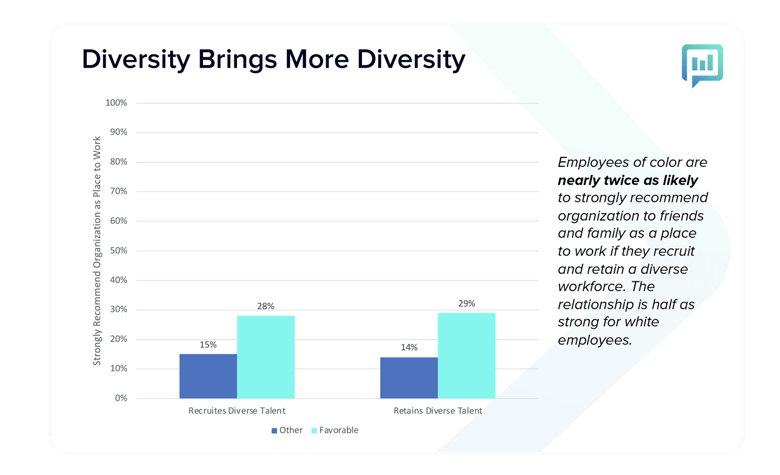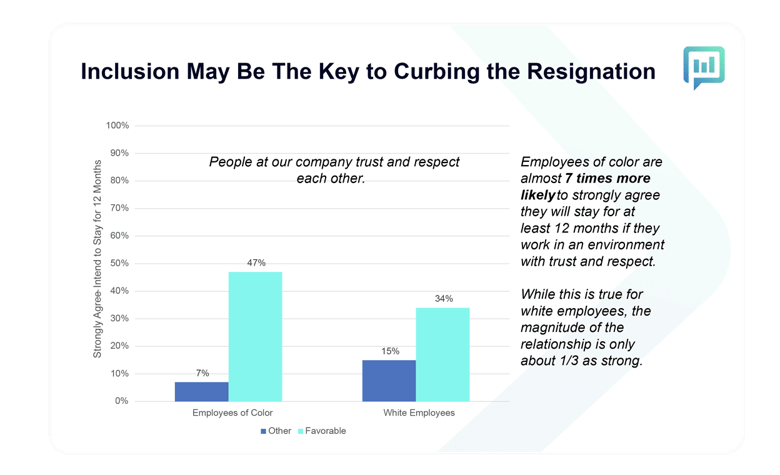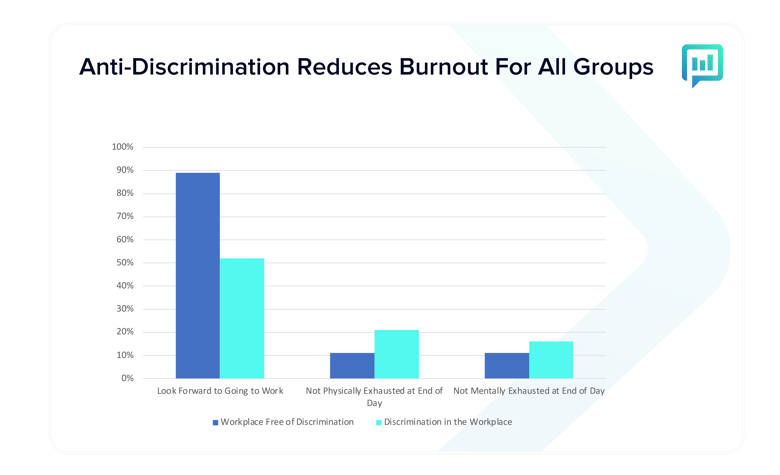
Breaking Down DE&I & Why It Matters in Return-to-Work Policies
By now, most everyone knows that DE&I stands for diversity, equity, and inclusion, and most know what those terms mean by definition. But, do you know what each term actually means to and for your organization?
Recent panel research by Perceptyx indicates that most organizations are still figuring that out. And that’s OK. (We are too!) The added challenge is that many organizations are truly trying to figure it out while also working to simultaneously make DE&I a priority in the workplace – especially when determining return-to-work plans in the wake of the pandemic.
How DE&I Impacts Employees
Diversity, equity, and inclusion tend to get lumped together because they are all interconnected. Collectively, DE&I is about seeking systemic change to make organizations a better workplace for all. While diversity, equity, and inclusion all impact employees’ sense of belonging, they are separate constructs, and each affects the workforce in different ways.
For our research, we asked a panel of 1,000 US workers about each concept individually and the topic as a whole. We inquired how DE&I is impacting employees as they consider returning to a physical, in-person work environment, the link to their overall sense of health and well-being, and a number of other workplace outcomes. Additionally, we asked questions to determine how diversity, equity, and inclusion, as separate ideas, correlate to typical measures of employee engagement. Here’s what we found out.
Diversity brings more diversity. Diversity is the easiest to measure because it’s based on demographics and numbers. It includes race, ethnicity, gender, disability, sexual orientation, and religion. In our research, we learned that people of color are nearly twice as likely to strongly recommend their organization to friends and family as a place to work if the organization prioritizes recruiting and retaining a diverse workforce. For white employees, the relationship is only half as strong. Companies are cognizant of this and are changing their recruiting efforts to find and hire more diverse candidates, knowing that, in turn, those people will be advocates for their company.

Equity is a key driver for bringing women of color back to the physical workplace. Equity should not be misconstrued for equality even though they are similar. It’s important to understand the difference. Equality simply means that each person is treated the same. For example, in a workplace, each employee has the same tools to do their jobs, the same access to benefits, etc. But equity means that people are given what they need to succeed, taking situational differences into consideration. Equity essentially levels the playing field for all involved. In work-from-home environments, equity may mean ensuring all employees have WiFi/Internet access and providing it to those who don’t. There are also equitable advantages to working from home. Each employee literally takes up the same amount of space in videoconferencing calls and are equally included: those Zoom squares are all the same size and microphones are the same volume. People with disabilities are able to work where they are most comfortable or get access to audio assistance, without drawing attention to accommodations. There are fewer instances of microaggressions, especially for women of color (i.e., no unwanted hair touching, comments on their appearance, etc.).
In our research, we found that the notion of equity highly impacted women of color’s desire to return to the office. Women of color are 12% more likely to want to return to an in-person workplace if they believe all employees are treated or will be treated fairly – regardless of age, race, gender, ability, etc. While equity is a key driver of willingness to return to work for women of color, interestingly, it did not impact other groups’ desire to return to the same degree.
.png?width=780&height=475&name=graph1-deidata-2%20(1).png)
Inclusion may be the key to curbing resignations. Inclusion in the workplace means having an environment where everyone feels trusted, respected, and accepted. Having an inclusive environment may also mean it’s diverse and equitable, but it may not. Inclusion is an active behavior and is the responsibility of all employees.
While inclusivity matters to all employees, it matters more to people of color. Our panel research found that employees of color are almost seven times more likely to strongly agree that they will stay at their company for at least 12 months if they feel trusted and respected. While white employees also want to feel trusted and respected, it doesn’t have as much bearing on their willingness to stay with the organization. In fact, the magnitude of the relationship is only about one-third as strong. It may seem like a no-brainer that there should be trust and respect in the workplace; our research shows there is work to be done across the board here.

Anti-discrimination matters most. For some organizations, current DE&I initiatives, which can be more passive or reactive to instances in the workplace, aren't effective enough for creating lasting change. Instead, some organizations are working toward taking a proactive stance against discrimination – acting to ensure the organization is free from bias and handling any incidents of discrimination promptly and completely. Based on our research, this has proven to benefit employees in unanticipated ways. In fact, employees who believe their organizations are free from discrimination experience less burnout than their counterparts. They are two times more likely to look forward to going to the office in the morning and only half as likely to be physically or mentally exhausted at the end of the workday. Burnout, and the effects of burnout, are hot topics these days, particularly as the pandemic has increased stress for most all employee groups. For organizations looking to curb burnout, anti-discrimination should be part of the solution.
What Does This Data Mean for Your DE&I Strategy?
It means employees, especially those in historically marginalized groups, want to be seen, heard, included, appreciated, and respected in their work environments. It means that people of color are feeling empowered to make more thoughtful choices about their employer, and are actively seeking more diverse, equitable, and inclusive workplaces.
While these feelings may not be new, the frequency and impact of these conversations are. People are talking and sharing things out loud. Even though they can sometimes be uncomfortable, DE&I conversations are being had both privately and publicly, and this is a good thing. It makes DE&I top of mind and ensures organizations are paying attention. It can also be a powerful differentiator as you strive to recruit top talent, and a powerful motivator to ensure the high-performing talent you have stays with you.
There’s plenty of research that proves positive diversity, equity, and inclusion practices can have a positive effect on businesses’ bottom lines, but our research also shows the human impact. DE&I is employee-driven, and perceptions matter – to people and the business.
